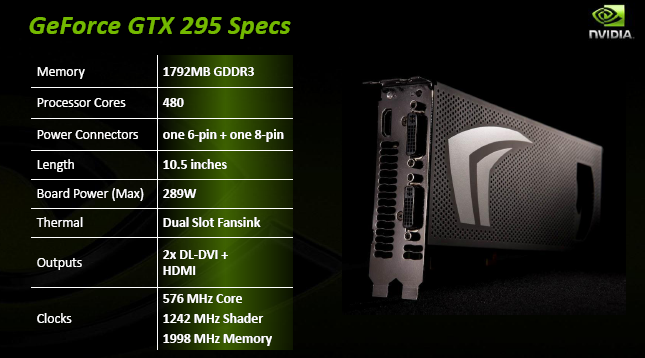The specs

Shipping with frequencies of 576MHz core, 1,242MHz shader, and 1,998MHz for the DDR3 memory and employing the same back-end - 28 ROPs, 448-bit memory bus, 896MB of RAM, on a per GPU basis, you'd be forgiven for thinking that it was a straight coupling, via SLI, of two 55nm GeForce GTX 260s, because the figures tally up exactly.
Instead, NVIDIA will be boosting the per-GPU shader-count from 216 to 240, matching GeForce GTX 280's, but totalling 480 on this dual-GPU card. Conjecturing out somewhat, a 55nm single-GPU part with 240 stream processors and faster clocks could well be in the offing.
Whilst ATI has been able to place two GPUs on a side-by-side basis on a PCB, opening up the possibility of single-slot cooling - a la Sapphire's ATOMIC - NVIDIA GeForce GTX 295 will remain a dual-slot card for obvious reasons.
Interestingly, NVIDIA's latest drivers bring multi-monitor support when running SLI, and that's what this card is all about. GTX 295 will provide two-head output when running SLI, of course, but up to three heads when in non-SLI mode, so, for example, you could have twin DVI and HDMI active at the same time.
Quad time
With one GTX 295 card constituting two internally-SLI'd GTX 260(+) cards, adding a second '295 brings Quad SLI back with a bang, harnessing four GPUs spread over two cards and, therefore, two x16 PCIe slots.
NVIDIA's documentation claims both single-card and multi-GPU performance ownership over Radeon HD 4870 X2 when evaluated at ultra-high resolutions, with an across-the-board (the puns get worse) lead of some 26 per cent, single GTX 295 vs. single Radeon HD 4870 X2. We'll investigate the claims in due course, but the underlying horsepower looks good.











